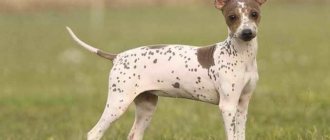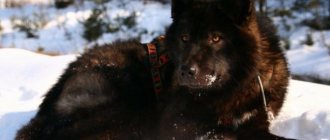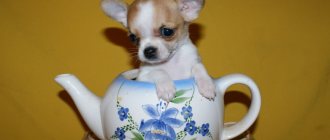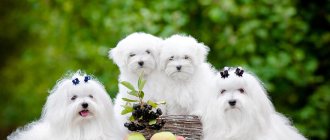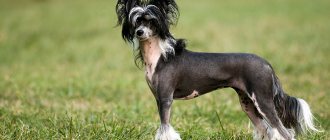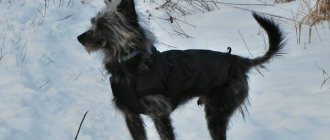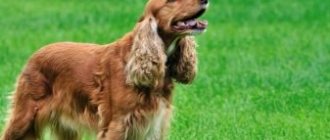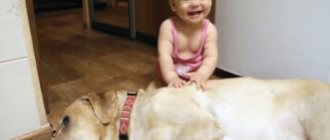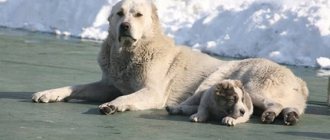The Canadian Eskimo dog or Eskimo Laika (English: canadian eskimo dog) is a breed of working sled dog native to the far north of Canada. This ancient breed is renowned for its ability to survive and work in some of the most challenging conditions on the planet. Quite numerous back in the 1950s, the breed is now considered one of the rarest dog breeds in the world and is on the verge of extinction. According to 2008 estimates, there are only 300 purebred dogs.
History of the breed
The “Canadian Eskimo dog” breed comes from Siberia and Eskimo-inhabited regions close to the Arctic Circle (Canada, Greenland and Alaska).
The number of such dogs decreased because the inhabitants of these areas did not maintain the breed, and because from the 50s to the 70s they experienced mass extermination. But later the Americans drew attention to this problem - in the last years of the last century they began to gradually reproduce them. Additional Information. In 2000, the provincial government of Nunavut recognized these animals as representing the Inuit region.
FAQ
Today the number of questions is small, because the breed is practically not popular in Russia.
Question to the expert
How to find a good, verified breeder?
First of all, research nurseries on the English-language Internet. Contact the owner of the nursery you like, if possible, fly to visit and look at the babies.
Do you need documents for transportation?
One “wonderful” story about documents. The French bulldog was transported by train, in a bag, under a large dose of sedative. We saved on a visit to the veterinarian and the appropriate certificate for transporting the dog. Do not do it this way.
Are the dogs very aggressive?
In general, the breed is not aggressive. It is difficult to answer for individuals.
Breed standards
Aggression is not normal for the breed.
Knowing the characteristics of the breed is important both for buyers, in order to avoid substitution when purchasing an animal, and for breeders and sellers.
Head
The head of such dogs is large, triangular and narrowed at the end.
Teeth
The Canadian Husky is a dog with sharp and strong teeth that leave marks reminiscent of cuts from scissors.
Nose
The color of the nose of Canadian huskies can be black or brown. There is even red with its admixture!
Eyes
The eyes of Eskimo huskies are shaped like almonds. The color varies - they are usually painted in dark tones, but occasionally they are yellow or blue.
Ears
Canadian Eskimo Huskies are a breed characterized by small, triangular, erect ears.
Neck
The hair on the neck (and in Eskimo breeds, although it is not long, is very strong and strong) males have more hair than females, which gives them a courageous and proud appearance.
Frame
The body is straight. Its height in the front half is approximately the same as in the back. The chest and lower back are quite clearly visible and noticeable.
Limbs
Since sled pets run a lot and at high speeds, the muscles of their hind legs become strong and clearly visible.
Tail
In most cases, these huskies walk with their long fluffy tail raised up.
Wool
Canadian Eskimo dogs are famous for their long hair, which falls out profusely in late summer.
Color
The coat can be dark brown, black or white.
Disqualifying faults
Non-compliance with breed standards can be indicated by both morphological and behavioral characteristics. External features include shortened fur as a result of physical intervention, a drooping tail and similar ears. Abnormal behavior - aggression or excessive fearfulness.
Hunting behavior
Eskimo huskies (photos of which are in the article) have strong hunting instincts. They are born hunters. Chasing animals brings them true joy.
If your pet is bored, you should take him hunting, this activity will bring him real pleasure. It is very interesting to observe the dog's behavior during this process. During the hunting season for fur (squirrel, sable, marten), the husky first searches the territory and uses its voice to signal the owner about the discovery of animals. If they are hunting birds, the dog distracts the game so that the owner can fire a shot. Similar behavior is observed during wild boar hunting.
If the owner goes after a large animal, the husky’s behavior changes to aggressive. The dog attacks the animal, driving it into the septic tank.
Features of feeding and training
Canadian huskies eat mainly meat and fish. Therefore, it is best to feed them these foods. A good owner cannot do without porridge - for example, buckwheat or rice.
They eat both meat and porridge
As for training, in order to maintain physical activity, you need to do various exercises with your pet. From throwing a stick at a husky to running in a harness and next to skis (these exercises are called skipulling and joring).
Maintenance, care
The thick fur of huskies allows the animals to feel great in low temperatures. It will not be difficult for them to settle down to sleep right in a snowdrift. But in hot climates, representatives of this breed are extremely uncomfortable. It is recommended that such a dog be kept outdoors rather than indoors.
Laikas are very active animals, and therefore they need to be walked for a long time every day and at the same time given physical activity.
When walking, it is best to choose an open space located as far as possible from the highway. If there are no such places, then the pet needs to be walked without letting it off the leash.
Representatives of this breed are distinguished by cleanliness, but frequent washing is contraindicated for them due to the thickness of the undercoat, which dries very poorly. To take care of the coat, the owner needs to comb his pet several times a week and use dry shampoos.
Feeding
After a husky puppy appears in the house, the owner’s first need is to provide the animal with daily nutrition. Here you can use both specialized (store-bought feed) and natural products. It is strictly forbidden to mix both of these options.
The growth and development of a dog depends on the diversity of its diet, especially in the early stages of life, when skeletal bones, muscles, etc. are being formed.
Worth knowing! Until six months of age, the puppy should eat 5 to 6 times; after the 6th month, reduce the number of meals to 3 to 4 times a day.
Adult animals should receive food twice a day, in the morning and evening hours
It is important to remember that the dog should always have a bowl of clean drinking water freely available to him.
The natural diet is represented by boiled or steamed food. The permitted products include the following:
- beef;
- pork;
- rabbit meat;
- bird;
- fish;
- milk products;
- occasionally raw eggs;
- vegetable crops.
There are some types of food that you should absolutely not give to huskies. This includes not only smoked, fried, salted and spicy foods, but also the following:
- pea grain;
- potato;
- wheat bread;
- sweets in any form;
- pasta.
A dog’s health and life expectancy depend on a high-quality diet. If you follow all feeding standards and properly care for your husky, it will live for about 10–15 years.
Upbringing
Before you bring the puppy home, you need to choose a place where he will sleep and eat, they must be strictly defined. A potential owner should remember that the puppy will go to the toilet after feeding and after waking up. To avoid further problems, the puppy must be taken outside on time, where he will relieve his natural needs. The main thing in this matter is perseverance and perseverance, only then the pet will begin to understand what it must do. By the age of two months, a husky puppy should have a clear idea of where its place is, where feeding occurs, obey the command “come to me” and have the correct reaction to the sound of a whistle, which will replace the voice command during the hunt.
Continuation of the reinforcement of this command and the call signs of the whistle must be reinforced after the puppy turns three months old during full walks. At this point, it is necessary to begin training the main commands. By 4 months of age, properly trained young dogs are mostly effortless and can do all of the above.
To stimulate obedience, it is important not to forget to praise the dog and give it its favorite treat, which the husky will appreciate. When raising a puppy, the owner must show persistence and firmness, but there should not be excessive cruelty
You need to know all the inclinations and characteristics of your pet in order to use them to develop the necessary skills in the animal. If there are harmful tendencies, then they must be nipped in the bud, otherwise they will later become habits that will be very difficult to get rid of. Laying the foundations of education for this breed occurs before the age of one year.
When raising a puppy, the owner must show persistence and firmness, but there should not be excessive cruelty. You need to know all the inclinations and characteristics of your pet in order to use them to develop the necessary skills in the animal. If there are harmful tendencies, then they must be nipped in the bud, otherwise they will later become habits that will be very difficult to get rid of. The laying of the foundations of education for this breed continues until the age of one.
Interesting Facts
There are many interesting facts about the Eskimo dog. For example:
- There is a known case of using dogs of the Canadian breed as actors. They played the role of direwolves of the Stark family in the series “Game of Thrones”.
- The breed is so rare that only one Inuit dog was found in Canada in 1963.
- Such pets are among the 5 most expensive dogs. The puppy costs $7,200.
The Eskimo husky is a loyal but stubborn animal. In the process of upbringing, it cannot be dealt with through pressure or coercion, only with patience, kindness and affection. Therefore, this breed is suitable only for people with a certain type of character.
Character
Initially, the Eskimo husky appeared and developed in a pack. Thanks to this, she developed an independent and wild disposition. Therefore, you should not expect unusual affection from an animal, although in general the dog’s attitude towards humans is quite positive, the dog rejoices in the owner’s praise. It may seem that the husky is not attached to its owner and behaves arrogantly, but this is not so. She also values relationships with people, but does not demonstrate this as clearly as other breeds.
The Eskimo husky has excellent guarding qualities. And if the owner put her as a watchman, then he definitely has nothing to worry about. The dog will never let a stranger through.
Having considered the description of the Eskimo husky breed and character, you should dwell on the intricacies of caring for the animal.
Nutrition
Feeding representatives of this dog breed does not cause any difficulties for the owner. Eskimo huskies eat much less food than other breeds, and overeating is not recommended for them. An overloaded stomach can cause your pet to develop obesity and other diseases. The dog must always be in sports uniform.
The food should contain boiled beef. The meat must be boiled for at least an hour.
The same should be done with fish. The feeding portion should be determined based on the dog's expected activity during the day. Dogs that participate in constant training and all kinds of physical exercise should eat more than less active ones.
The dog should receive boiled bones in its diet, rich in minerals necessary for its body. In addition, it is recommended to include a vitamin and mineral complex.
The main food should contain finely chopped raw vegetables, which include many useful elements. A small amount of salt is allowed.
The strict recommendation is that an adult dog should not receive food during the day; the regime should be followed in the morning and evening.
Eskimo Spitz puppies
This breed is rare in our country. Therefore, it is difficult to buy a purebred puppy. You need to find a good nursery. The dogs in it must be well-groomed and healthy. They must have all the necessary documents, a veterinary passport. You need to get to know the mother: she should not be aggressive or cowardly, and her appearance should correspond to the breed.
When choosing a puppy, you need to examine it. A healthy dog has smooth, thick fur, without bald patches or dandruff. The eyes are clean, there is no unpleasant odor. The abdomen is soft, not swollen or sunken. The puppy should be moderately well-fed, cheerful, and curious.
The price of a purebred Eskimo Spitz starts from 30 thousand rubles. Show class puppies cost 50-70 thousand. A dog with minor breed defects can be bought for 15-20 thousand. You just need to take into account that she will not be allowed to breed. But such a dog can become a good companion.
The photo shows what the puppies look like:
Watch an interesting video about representatives of this breed:
Video: Dog breed American Eskimo Spitz (Eski), white handsome
Video: Dog breed American Eskimo Spitz
The American Eskimo Spitz is a beautiful, obedient dog with a calm, cheerful personality. Well suited for active people, families with children. With the right care, she will become a loyal friend and an ideal companion.
Tamaskan dog
This breed was bred in Finland on the basis of huskies, Alaskan malamutes, Siberian huskies and German shepherds exported from the USA. The wolf-like dog is not officially recognized by the FCI. Dog breeders from all continents have become interested in it. The elegant and picturesque-looking dog has highly developed mental abilities and excellent working qualities, and demonstrates high results in sports competitions. Animals do not tolerate loneliness well and do not like to be left at home alone. Aggressive behavior is not typical for Tamaskans, but if they suspect a threat, the dog’s actions will be unpredictable. Among his relatives, the dog prefers to be a leader. He allows himself to be stroked only by those who are especially trusted.
Photo gallery
We invite you to look at our selection of photos and see the unprecedented fortitude and physical endurance of these northern representatives of man’s four-legged friends.
Health
This type of husky has fairly good health . The only disease to which they are prone is a disease of the musculoskeletal system.
It is worth noting that at home, even if you constantly walk a lot with your pet, she will still not receive the physical activity she needs, and this will undoubtedly affect her health. To protect your pet from unnecessary diseases, you should give him a small amount of cottage cheese every day and do not forget to add raw vegetables to his food.
This breed does not require special care; sometimes it needs to be brushed. In this breed, the word “care” more implies in its meaning providing the dog with proper nutrition and constant physical activity. In no case should the animal be given baked, sweet, spicy, salty foods; it is also not advisable to constantly feed them dry food; especially in this breed, they have a very bad effect on the dog’s kidneys and liver.
Literature[edit | edit code]
- Escimo Dog of the Canadian Arctic // Canadian Geographical Journal. - 1940. - No. 2. - P. 97-108.
- Geneviève Montcombroux.
The Inuit Dog of the Polar North: Revised and expanded third edition of The Canadian Inuit Dog: Canada's Heritage. 3rd Edition. — CreateSpace Independent Publishing Platform, 2022. — 220 p. — ISBN 978-1517610579. - Max Murray.
Canadian Eskimo Dog Training Guide. — CreateSpace Independent Publishing Platform, 2016. — 112 p. — ISBN 9781534978775. - Tammy Gagne.
Huskies, Mastiffs and Other Working Dogs / Capstone Global Library Limited. - London: Raintree. — ISBN 9781474720861.
Notes
- Fauna Boreali-americana, Or, The Zoology of the Northern Parts of British America: Containing Descriptions of the Objects of Natural History Collected on the Late Northern Land Expeditions, Under Command of Captain Sir John Franklin, RN by John
Richardson, William Swainson, William Kirby, published by J. Murray, 1829 - The Menageries: Quadrupeds, Described and Drawn from Living Subjects
by James Rennie, Society for the Diffusion of Useful Knowledge (Great Britain). Contributor Charles Knight, William Clowes, Longman, Rees, Orme, Brown, and Green, Oliver & Boyd, published by Charles Knight, 1829 - Coppinger, Ray.
Dogs: a Startling New Understanding of Canine Origin, Behavior and Evolution. - 2001. - P. 352. - ISBN 0-684-85530-5. - The Variation of Animals and Plants Under Domestication Part One
by Charles Darwin, 1885
